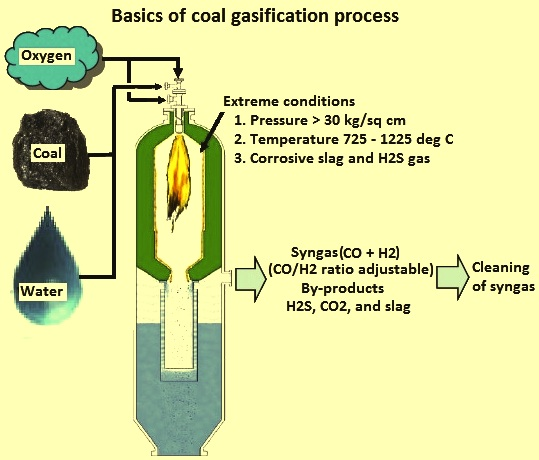Biodiversity & Environment
Coal Gasification
- 03 Feb 2022
- 4 min read
For Prelims: Coal Gasification, Syngas, Hydrogen Economy, Concerns Associated with Coal Gasification Plants
For Mains: Coal Gasification, Syngas, Hydrogen Economy, Concerns Associated with Coal Gasification Plants
Why in News
Recently, the Delhi-based non-profit, Centre for Science and Environment (CSE), has raised concerns about the Union Government’s announcement on coal gasification projects in the Budget 2022-23.
- The budget proposed four pilot projects for coal gasification and conversion of coal into chemicals required for the industry.
- According to CSE, the process of coal gasification is not attractive from a climate change point of view.
What is Coal Gasification?
- Process: Coal gasification is a process in which coal is partially oxidised with air, oxygen, steam or carbon dioxide to form a fuel gas.
- This gas is then used instead of piped natural gas, methane and others for deriving energy.
- In-situ gasification of coal – or Underground Coal Gasification (UCG) – is the technique of converting coal into gas while it is still in the seam and then extracting it through wells.
- Production of Syngas: It produces Syngas which is a mixture consisting primarily of methane (CH4), carbon monoxide (CO), hydrogen (H2), carbon dioxide (CO2) and water vapour (H2O).
- Syngas can be used to produce a wide range of fertilizers, fuels, solvent and synthetic materials.
- Significance: Steel companies typically use coking coal in their manufacturing process. Most of the coking coal is imported and is expensive.
- To cut costs, plants can use syngas, which comes from coal gasification plants in the place of coking coal.
- It is primarily used for electricity generation, for the production of chemical feedstocks.
- The hydrogen obtained from coal gasification can be used for various purposes such as making ammonia, powering a hydrogen economy.
What is the Hydrogen Economy?
- It is an economy that relies on hydrogen as the commercial fuel that would deliver a substantial fraction of a nation’s energy and services.
- Hydrogen is a zero-carbon fuel and is considered an alternative to fuel and a key source of clean energy.
- It can be produced from renewable sources of energy such as solar and wind.
- It is an envisioned future where hydrogen is used as fuel for vehicles, energy storage and long-distance transport of energy.
- The different pathways to use hydrogen economy includes hydrogen production, storage, transport and utilization.
- In 1970, the term 'Hydrogen Economy' was coined by John Bockris.
- He mentioned that a hydrogen economy can replace the current hydrocarbon-based economy, leading to a cleaner environment.
What are the Concerns associated with Coal Gasification Plants?
- Environmental Perspective: Coal gasification actually produces more carbon dioxide than a conventional coal-powered thermal power plant.
- According to CSE estimates, one unit of electricity generated by burning gasified coal generates 2.5 times more carbon dioxide than what would result when burning the coal directly.
- Efficiency Perspective: The syngas process converts a relatively high-quality energy source (coal) to a lower quality state (gas) and consumes a lot of energy in doing so.
- Thus, the efficiency of conversion is also low.







